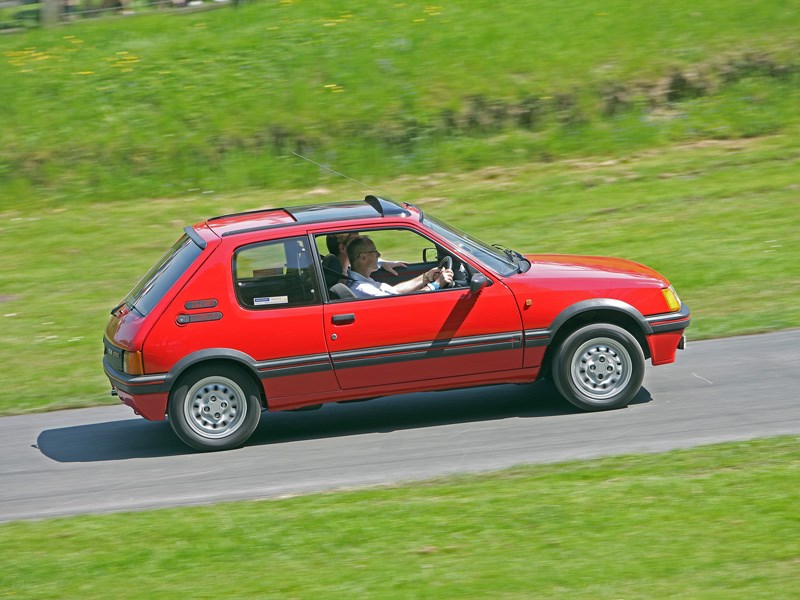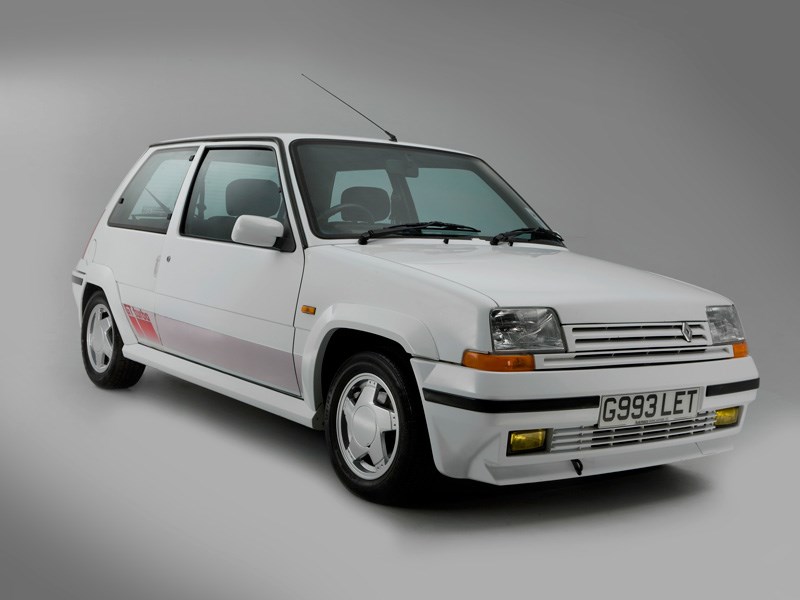Renualt’s response to the 205GTI used turbocharging to try and gain the upper hand. Richard Gunn pitches them against each other, and makes the toughest of calls…
Model History
The original GTI, which appeared in April 1984, put out 105bhp from its 1580cc overhead cam engine. Phase 1 cars had a two-spoke steering wheel, linear heater controls, black and red velour seats and bright red carpeting. The exterior boasted auxiliary lamps in the front spoiler, red inserts in the bumpers and 14in ‘pepperpot’ alloy wheels. A new cylinder head and camshaft added an extra 10bhp in April 1986, but it wasn’t until January 1988 that more radical alterations ushered in the Phase 1.5. This featured a remodeled dashboard, a three-spoke steering wheel and ‘Monaco’ tweed seat trim. In August 1989, Quartet black and red velour seats became the norm along with central locking. The final Phase 2 1.6 lasted from September 1990 to September 1992, and could be spotted by its darker dashboard and door cards, black bumpers, clear front indicators, and a reversing light and fog lamp in the rear bumper.
The 1.6’s big brother, the 130bhp 1.9, lasted from December 1986 to April 1994 and had electric windows, central locking, half-leather seats and 15in Speedline alloy wheels. Changes then followed much the same pattern as the Phases on the 1.6.
The original Renault 5 came about by accident – designer Michel Boué idly sketched it in 1968 over a picture of a Renault 4. Renault’s management was so impressed that it authorised it for production in 1972. It went on to sell over 5.5 million examples during the next 24 years.
Renault was quick with a hot hatch version dubbed the Alpine (which had to be called ‘Gordini’ in Britain because Chrysler already had the Alpine name). There was even a mid-engined R5 Turbo Group 4 homologation special, which was, quite frankly, insane. The second-generation ‘Supercinq’ turned up in 1984 with Renault once again turning to turbocharging for its range-topping hot hatch. The 1397cc – which dated from 1962 – pushrod ‘Cléon-Fonte’ engine seemed a poor choice on paper, but a Garrett T2 turbocharger boosted the 1985 GT Turbo’s power to 115bhp – more than the 1984 1.6 205 and equal to the 1986 version.
Peugeot hit back with the 130bhp 1.9 GTI in late 1986 and Renault responded with the Phase II GT Turbo with watercooled turbocharging that increased power to 118bhp. The Clio 16v and Williams spelled the end for the GT Turbo in late 1991.
On the Road
With its friendlier, more voluptuous shape, the Peugeot 205 GTI looks more modern than the Renault 5, and even more welcoming without the excess of fussy plastic decorating the outside.
It’s the more timeless design of the pair, and it’s one that belies its 30-yearold origins, one of those shapes with almost perfect balance and poise, and not a line out of place.
It’s only when you get inside that it leaps back to the 1980s, with greys, blacks and a riot of red. The dashboard is more sensible than the R5’s though.
Those expecting a bit of meat will be disappointed by the tinniness of the exhaust when the car is fi red up. This ends when you slip the car into an easy first gear and give the throttle some heavy right foot. The Pug revs freely and pulls hard from 4000rpm, and it sounds good, too, even if lightweight build means it’s loud.
It grips well, although drive one on old tyres, and you could suffer from turn-in understeer or that oft-talked about lift-off oversteer. But in reality, a 205 GTI on modern rubber will enjoy a grippy roller-skate ride. The slightest movement of an unassisted 205 GTI’s wheel is echoed by electric response on the road. Models with PAS are slightly woollier.
Body roll is minimal, but more pronounced than in the R5. Disc brakes front and rear mean that the larger-engined GTI is an easy thing to bring to a halt, but why would you really want to? It’s a car that both encourages driving and smiling. And the more you drive it, the bigger the smiles will be.
Fans of the second-generation Renault 5 always take great delight in telling you that none other than Marcello Gandini – of Lamborghini Countach fame – designed it. And it sort of shows. In contrast to the rounded 205, the R5 is all hard edges and sharp angles.
On the GT Turbo, it’s emphasized even more by a chunky body kit and fake rear wheel cooling grilles. The inside echoes the outside; the steering wheel and gearknob are the most curvaceous items and the overhanging lip above the gauges gives the Renault cabin a very distinctive look.
In action, the GT Turbo has almost none of lesser R5s’ body roll. It’s a very competent car on corners and there’s more stiffness and less understeer than on the Peugeot, albeit at the cost of ride quality. And overall, it covers ground alarmingly quickly with little real effort required.
The unassisted steering is heavy at lower speeds, the clutch pedal hefty. But the steering frees up as you pile on the speed and offers plenty of feedback, but never does it feel as connected as the Peugeot’s. The Renault initially feels slower at first, as the 205 has more progressive power delivery. But then the turbo spools up, defeats the lag and whoosh! – it’s like you’re being shoved hard in the back. It’s the sort of thing that could catch an unwary driver out, especially if it happens while the front wheels are turned, halfway round a wet corner. In a straight line, the R5 feels much more dramatic and pocket rocket-like than the Peugeot.
This was one of the most fiercely contested battles in the hot hatch market sector back in the mid-1980s. Forget the Volkswagen Golf GTI – that cost considerably more money than either of these young French chargers – and focus instead on similarly priced contenders, such as the Fiat Uno Turbo, Ford Fiesta XR2 and MG Metro Turbo. When you do that, you’ll see why these two dominated the column inches.
And out of this legendary pairing, contemporary magazine road tests seemed evenly split between the Peugeot and the Renault, with the 5 GT Turbo tending to squeak a win on points.
What’s interesting is just how the passage of time has altered this view. Now, the Peugeot has the greater following, with the Renault being the more underground choice for ‘80s aficionados. But taking a more objective view today, and choosing between these two hot-hatch protagonists is as difficult as it ever was.
And, let’s be honest, any decision will be based very much on what you’re looking for from your ride. If feel, communication, and delicacy of response are your thing, then there’s no doubt that the 205 GTI is the car for you. Its hair-trigger throttle, effusive steering, and sheer joie de vivre make this a car that’s near impossible not to fall in love with.
But for those who demand the best acceleration, and ability to demolish A to B runs in the minimum possible time, then there’s no question that the Renault 5 GT Turbo is the car that should end up in your garage.
As for the winner, we’d probably take the Peugeot for everyday use, as it’s more practical, less frenetic, and more fun in the corners. It’s more timeless in its appeal, less rooted in the 1980s and slips more easily into the role of usable classic. But if a Renault pulled up alongside at the lights, we might just get pangs of regret.

